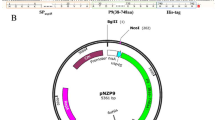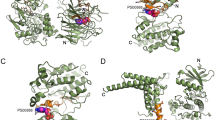Abstract
Glyoxalase I (GLO1), together with glyoxalase II and the co-factor GSH, comprise the glyoxalase system, which is responsible for the detoxification of the cytotoxic glycolytic-derived metabolite methylglyoxal (MG). We, and others, have previously reported that GLO1 is subjected to several post-translational modifications, including a NO-mediated modification and phosphorylation. In this study, we demonstrate that GLO1 is a substrate for calcium, calmodulin-dependent protein kinase II (CaMKII). Site-directed mutagenesis of several serine and threonine residues revealed that CaMKII induced phosphorylation of GLO1 at a single site Thr-106. Mutagenesis of Thr-106 to Ala in GLO1 completely abolished the CaMKII-mediated phosphorylation. A phosphopeptide bracketing phosphothreonine-106 in GLO1 was used as an antigen to generate polyclonal antibodies against phosphothreonine-106. By using this phospho-specific antibody, we demonstrated that TNF induces phosphorylation of GLO1 on Thr-106. Furthermore, we investigated the role of NO-mediated modification and phosphorylation of GLO1 in the TNF-induced transcriptional activity of NF-κB. Overexpression of WT GLO1 suppressed TNF-induced NF-κB-dependent reporter gene expression. Suppression of the basal and TNF-induced NF-κB activity was significantly stronger upon expression of a GLO1 mutant that was either deficient for the NO-mediated modification or phosphorylation on Thr-106. However, upon overexpression of a GLO1 mutant that was deficient for both types of modification, the suppressive effect of GLO1 on TNF-induced NF-κB activity was completely abolished. These results suggest that NO-modification and phosphorylation of GLO1 contribute to the suppression of TNF-induced NF-κB-dependent reporter gene expression. In line with this, knock-down of GLO1 by siRNA significantly increased TNF-induced NF-κB-dependent reporter gene expression. These findings suggest that phosphorylation and NO-modification of glyoxalase I provides another control mechanism for modulating the basal and TNF-induced expression of NF-kappaB-responsive genes.




Similar content being viewed by others
Abbreviations
- 2-DE:
-
2-Dimensional gel electrophoresis
- GLO1:
-
Glyoxalase I
- MG:
-
Methylglyoxal
- TNF:
-
Tumour necrosis factor
- GSNO:
-
S-nitrosogluthathione
- IEF:
-
Isoelectro focusing
- CaM:
-
Calmodulin
References
Kalapos MP (1999) On the promine/retine theory of cell division: now and then. Biochim Biophys Acta 1426:1–16
Thornalley PJ (1996) Pharmacology of methylglyoxal: formation, modification of proteins and nucleic acids, and enzymatic detoxification–a role in pathogenesis and antiproliferative chemotherapy. Gen Pharmacol 27:565–573. doi:10.1016/0306-3623(95)02054-3
Dukic-Stefanovic S, Schinzel R, Riederer P, Munch G (2001) AGES in brain ageing: AGE-inhibitors as neuroprotective and anti-dementia drugs? Biogerontology 2:19–34. doi:10.1023/A:1010052800347
Van Herreweghe F, Mao J, Chaplen FW et al (2002) Tumor necrosis factor-induced modulation of glyoxalase I activities through phosphorylation by PKA results in cell death and is accompanied by the formation of a specific methylglyoxal-derived AGE. Proc Natl Acad Sci USA 99:949–954. doi:10.1073/pnas.012432399
Thornalley PJ (1990) The glyoxalase system: new developments towards functional characterization of a metabolic pathway fundamental to biological life. Biochem J 269:1–11
Chen F, Wollmer MA, Hoerndli F et al (2004) Role for glyoxalase I in Alzheimer’s disease. Proc Natl Acad Sci USA 101:7687–7692. doi:10.1073/pnas.0402338101
Hovatta I, Tennant RS, Helton R et al (2005) Glyoxalase 1 and glutathione reductase 1 regulate anxiety in mice. Nature 438:662–666. doi:10.1038/nature04250
Rulli A, Carli L, Romani R et al (2001) Expression of glyoxalase I and II in normal and breast cancer tissues. Breast Cancer Res Treat 66:67–72. doi:10.1023/A:1010632919129
Davidson SD, Cherry JP, Choudhury MS, Tazaki H, Mallouh C, Konno S (1999) Glyoxalase I activity in human prostate cancer: a potential marker and importance in chemotherapy. J Urol 161:690–691. doi:10.1016/S0022-5347(01)61996-7
Ranganathan S, Tew KD (1993) Analysis of glyoxalase-I from normal and tumor tissue from human colon. Biochim Biophys Acta 1182:311–316
Sakamoto H, Mashima T, Kizaki A et al (2000) Glyoxalase I is involved in resistance of human leukemia cells to antitumor agent-induced apoptosis. Blood 95:3214–3218
Thornalley PJ, Edwards LG, Kang Y et al (1996) Antitumour activity of S-p-bromobenzylglutathione cyclopentyl diester in vitro and in vivo. Inhibition of glyoxalase I and induction of apoptosis. Biochem Pharmacol 51:1365–1372. doi:10.1016/0006-2952(96)00059-7
Kavarana MJ, Kovaleva EG, Creighton DJ, Wollman MB, Eiseman JL (1999) Mechanism-based competitive inhibitors of glyoxalase I: intracellular delivery, in vitro antitumor activities, and stabilities in human serum and mouse serum. J Med Chem 42:221–228. doi:10.1021/jm9708036
de Hemptinne V, Rondas D, Vandekerckhove J, Vancompernolle K (2007) Tumour necrosis factor induces phosphorylation primarily of the nitric-oxide-responsive form of glyoxalase I. Biochem J 407:121–128. doi:10.1042/BJ20070379
Tombes RM, Faison MO, Turbeville JM (2003) Organization and evolution of multifunctional Ca(2+)/CaM-dependent protein kinase genes. Gene 322:17–31. doi:10.1016/j.gene.2003.08.023
Vanden Berghe W, Plaisance S, Boone E et al (1998) p38 and extracellular signal-regulated kinase mitogen-activated protein kinase pathways are required for nuclear factor-kappaB p65 transactivation mediated by tumor necrosis factor. J Biol Chem 273:3285–3290. doi:10.1074/jbc.273.6.3285
Deswal R, Sopory SK (1999) Glyoxalase I from Brassica juncea is a calmodulin stimulated protein. Biochim Biophys Acta 1450:460–467. doi:10.1016/S0167-4889(99)00047-6
Ranganathan S, Walsh ES, Godwin AK, Tew KD (1993) Cloning and characterization of human colon glyoxalase-I. J Biol Chem 268:5661–5667
Vancompernolle K, Boonefaes T, Mann M, Fiers W, Grooten J (2000) Tumor necrosis factor-induced microtubule stabilization mediated by hyperphosphorylated oncoprotein 18 promotes cell death. J Biol Chem 275:33876–33882. doi:10.1074/jbc.M004785200
Greif DM, Sacks DB, Michel T (2004) Calmodulin phosphorylation and modulation of endothelial nitric oxide synthase catalysis. Proc Natl Acad Sci USA 101:1165–1170. doi:10.1073/pnas.0306377101
Wajant H, Pfizenmaier K, Scheurich P (2003) Tumor necrosis factor signaling. Cell Death Differ 10:45–65. doi:10.1038/sj.cdd.4401189
Perkins ND (2007) Integrating cell-signalling pathways with NF-kappaB and IKK function. Nat Rev Mol Cell Biol 8:49–62. doi:10.1038/nrm2083
Hayden MS, Ghosh S (2008) Shared principles in NF-kappaB signaling. Cell 132:344–362. doi:10.1016/j.cell.2008.01.020
Kamata H, Honda S, Maeda S, Chang L, Hirata H, Karin M (2005) Reactive oxygen species promote TNFalpha-induced death and sustained JNK activation by inhibiting MAP kinase phosphatases. Cell 120:649–661. doi:10.1016/j.cell.2004.12.041
Ventura JJ, Hubner A, Zhang C, Flavell RA, Shokat KM, Davis RJ (2006) Chemical genetic analysis of the time course of signal transduction by JNK. Mol Cell 21:701–710. doi:10.1016/j.molcel.2006.01.018
Inoue Y, Choi BY, Murata K, Kimura A (1990) Sexual response of Saccharomyces cerevisiae: phosphorylation of yeast glyoxalase I by a cell extract of mating factor-treated cells. J Biochem 108:4–6
Shin R, Alvarez S, Burch AY, Jez JM, Schachtman DP (2007) Phosphoproteomic identification of targets of the Arabidopsis sucrose nonfermenting-like kinase SnRK2.8 reveals a connection to metabolic processes. Proc Natl Acad Sci USA 104:6460–6465. doi:10.1073/pnas.0610208104
Bers DM (2007) Going to cAMP just got more complicated. J Physiol 583:415–416. doi:10.1113/jphysiol.2007.140764
Stuehr DJ (1999) Mammalian nitric oxide synthases. Biochim Biophys Acta 1411:217–230. doi:10.1016/S0005-2728(99)00016-X
Schneider JC, El Kebir D, Chereau C et al (2003) Involvement of Ca2+/calmodulin-dependent protein kinase II in endothelial NO production and endothelium-dependent relaxation. Am J Physiol Heart Circ Physiol 284:H2311–H2319
Meggio F, Pinna LA (2003) One-thousand-and-one substrates of protein kinase CK2? FASEB J 17:349–368. doi:10.1096/fj.02-0473rev
Cameron AD, Olin B, Ridderstrom M, Mannervik B, Jones TA (1997) Crystal structure of human glyoxalase I—evidence for gene duplication and 3D domain swapping. EMBO J 16:3386–3395. doi:10.1093/emboj/16.12.3386
Author information
Authors and Affiliations
Corresponding author
Rights and permissions
About this article
Cite this article
de Hemptinne, V., Rondas, D., Toepoel, M. et al. Phosphorylation on Thr-106 and NO-modification of glyoxalase I suppress the TNF-induced transcriptional activity of NF-κB. Mol Cell Biochem 325, 169–178 (2009). https://doi.org/10.1007/s11010-009-0031-7
Received:
Accepted:
Published:
Issue Date:
DOI: https://doi.org/10.1007/s11010-009-0031-7




